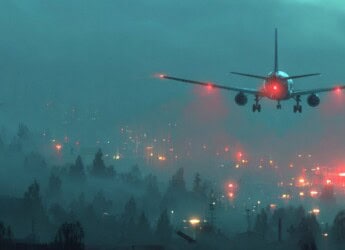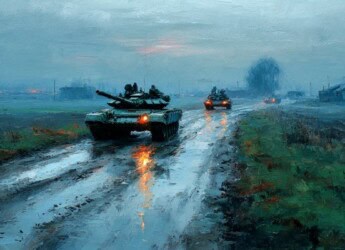Editor’s Note: ComplexDiscovery OÜ continues its ongoing coverage of the Russia-Ukraine conflict with this update on the Russia-Ukraine conflict as of June 8, 2024. It covers significant military movements, strategic deployments, and high-level diplomatic engagements, providing a clear picture of the current state of the war. This narrative is crucial for understanding the rapidly evolving dynamics of the conflict and its broader implications.
The information detailed here is particularly important for the United States and Europe as it underscores the ongoing need for sustained support to Ukraine. The conflict not only affects regional stability in Eastern Europe but also has significant implications for global security and geopolitical balance. Continued Western support, including military aid and diplomatic efforts, is essential to counteract Russian aggression and support Ukraine’s sovereignty.
Source Note: One of the most accurate and detailed sources for ongoing updates on the Ukraine crisis is the Russian Offensive Campaign Assessment from the Institute for the Study of War. The Institute for the Study of War (ISW) is a 501(c)(3) organization and produces strictly non-partisan, non-ideological, fact-based research. ISW seeks to promote an informed understanding of war and military affairs through comprehensive, independent, and accessible open-source research and analysis. ISW’s research is made available to the general public, military practitioners, policymakers, and media members. Providing a daily synthesis of key events related to the Russian aggression against Ukraine, ISW updates may benefit investigators and litigators as they follow the business, information technology, and legal trends and trajectories impacted by and stemming from the current Russo-Ukrainian conflict.
For those seeking to grasp the full scope of this evolving landscape, the complete updates from the Institute for the Study of War serve as an invaluable resource.
Content Assessment: From Kharkiv to Paris: Analyzing the Latest Moves in the Russia-Ukraine Conflict
Information - 92%
Insight - 93%
Relevance - 90%
Objectivity - 93%
Authority - 94%
92%
Excellent
A short percentage-based assessment of the qualitative benefit expressed as a percentage of positive reception of the recent update on the Russo-Ukrainian conflict as reported by ComplexDiscovery OÜ and sourced from the Institute for the Study of War.
Background Note: ComplexDiscovery’s staff offers distinctive perspectives on the Russo-Ukrainian war and Iran-Israel conflict, informed by military experience on the West German, East German, and Czechoslovakian border during the Cold War and in Sinai as part of Camp David Accord compliance activities. This firsthand regional knowledge, combined with proficiency in cybersecurity, information governance, and eDiscovery, enables multifaceted analysis of these conflicts, including the critical impact of cyber warfare, disinformation, and digital forensics on modern military engagements. This unique background positions ComplexDiscovery to provide valuable insights for conflict-related investigations and litigation, where understanding the interplay of technology, data, and geopolitical factors is crucial.
Russo-Ukrainian Conflict Update*
From Kharkiv to Paris: Analyzing the Latest Moves in the Russia-Ukraine Conflict
ComplexDiscovery Staff
The current conflict between Russia and Ukraine has entered a new and critical phase as of June 8, 2024. Recent military maneuvers, strategic deployments, internal political dynamics, and high-level diplomatic engagements indicate significant developments that are reshaping the battlefield and influencing the broader geopolitical landscape.
Reports indicate that Russian forces are being transferred to the Ukrainian-Russian border near Kharkiv Oblast. Notably, these forces include elements of the Akhmat Spetsnaz, under the command of Apty Alaudinov. These movements suggest a potential for immediate combat deployment or reinforcement of existing groups in the region. Alaudinov has noted that the “Kashtan” detachment, previously known as Akhmat “Kamerton,” is now active in the Kharkiv direction. This strategic redeployment is raising questions about Russia’s immediate intentions and its long-term strategy in this contested area.
Military observers in Ukraine have highlighted that only a fraction of the 30,000 personnel Russia generates monthly reaches the frontlines. This limited reinforcement capability has allowed Russia to maintain modest operational and strategic reserves. Despite generating significant numbers of new recruits, the effective combat replacement and reinforcement rate for Russian operational groupings remains constrained. This indicates ongoing challenges in Russia’s force generation and deployment strategies.
On the night of June 7-8, Ukrainian forces executed a drone strike against a Russian military airfield in the North Ossetia-Alania Republic, targeting the Mozdok Airbase. This strike demonstrates Ukraine’s continued capability to hit strategic Russian military assets, causing minor damage and fires. The ability to conduct such strikes highlights Ukraine’s resilience and tactical ingenuity in the face of a protracted conflict.
Russian strikes have significantly damaged Ukraine’s energy infrastructure. Ukrainian Prime Minister Denys Shmyhal reported that only 27% of large thermal power plants are operational. The reduction in energy generation capacity poses severe challenges for Ukraine, especially as the country prepares for the winter of 2024-2025. Shmyhal emphasized that recent Russian strikes have knocked out 9.2 gigawatts of generation capacity, which is half of what Ukraine used in Winter 2023-2024. The ongoing damage to the energy grid continues to strain Ukraine’s ability to meet its domestic energy needs.
In a significant diplomatic engagement, US President Joe Biden met with Ukrainian President Volodymyr Zelensky in Paris on June 7. Their discussions focused on the battlefield situation, security capabilities, and preparations for a bilateral security agreement. This meeting underscores the continued strategic partnership and support from the US to Ukraine. Biden apologized for the delays in US security assistance and reiterated US support for Ukraine against Russian aggression. Zelensky emphasized the need for more security assistance to strengthen Ukraine’s defenses and to strike military targets in Russia to mitigate cross-border threats.
Economic strains within Russia are becoming increasingly evident as the conflict drags on. Elvira Nabiullina, the longtime head of the Russian Central Bank, remains a significant figure among President Vladimir Putin’s economic advisors. Despite pressures to fully support the war effort, Nabiullina has expressed concerns about labor shortages and economic stability. In his recent speech at the St. Petersburg International Economic Forum (SPIEF), Putin addressed these issues, framing economic challenges positively to prepare Russian citizens for prolonged sacrifices. He outlined a 10-point plan to grow the Russian economy, acknowledging the demographic challenges and labor shortages exacerbated by the war.
An assassination attempt on June 7 targeted Hennadiy Matsehora, the former Russian occupation mayor of Kupyansk, leaving him in critical condition. This incident exemplifies the ongoing internal conflicts and targeted violence associated with the occupation. The Ukrainian Kharkiv Oblast Prosecutor’s Office has noted Matsehora’s defection to Russian forces and his subsequent assistance in the occupation, for which he is being tried in absentia for treason.
President Putin has articulated a strategy for victory in Ukraine that relies on gradual, creeping advances and a war of attrition. This approach assumes that Ukrainian forces will be unable to reclaim significant territory and that Western support will eventually diminish. Putin’s comments reflect a calculated approach to sustain offensive operations without the need for rapid mobilization or dramatic victories. He believes that the current pace of Russian advances will eventually allow Russia to achieve its territorial objectives and that the West will tire of supporting Ukraine over time.
Recent reports emphasize the importance of sustained Western support for Ukraine. Delayed security assistance has previously constrained Ukrainian capabilities, highlighting the need for timely and consistent aid. The West’s commitment to providing necessary equipment and weapons is crucial for Ukraine to effectively contest Russian advances.
Putin has indirectly indicated that Ukrainian strikes on Russian territory with Western-provided weapons do not constitute a trigger for Russian nuclear escalation. This statement aligns with past observations that many of Russia’s “red lines” are likely designed as information operations rather than actual thresholds for escalation.
In northern Kharkiv Oblast, Russian forces reportedly had roughly 35,000 personnel in the international border area as part of the Northern Grouping of Forces when they started offensive operations on May 10. Ukrainian sources have indicated that the Russian military initially sought to concentrate at least 50,000 to 70,000 personnel in the international border area as of early May. Reports suggest that the Russian military command is redeploying unspecified units and drone operators from the Kherson direction to the Kharkiv direction.
On the Southern Axis, Russian forces continued offensive operations in the Donetsk-Zaporizhia Oblast border area south of Velyka Novosilka. Additionally, Russian forces launched several unsuccessful attacks on Ukraine’s limited tactical bridgehead in the eastern bank of Kherson Oblast near Krynky on June 7 and 8.
Russian forces conducted limited drone and missile strikes against Ukraine overnight on June 7-8. Ukrainian Air Force Commander Lieutenant General Mykola Oleshchuk reported that Russian forces launched a Kh-59 cruise missile from Kursk Oblast and 13 Shahed-136/131 drones from Kursk Oblast and occupied Cape Chauda, Crimea. Ukrainian forces shot down the Kh-59 missile and nine Shahed drones over Kharkiv, Zaporizhia, Poltava, and Dnipropetrovsk oblasts.
Russian defense enterprises continue to develop electronic warfare (EW) capabilities to defend against Ukrainian drone strikes. Sergey Shandobylo, Development Director of Russian EW and anti-drone development company Trimix (3mx), stated that 3mx is developing an EW drone jammer capable of turning off the engines of enemy drones mid-air, with plans to introduce this jammer by the end of 2024.
The conflict between Russia and Ukraine remains dynamic and complex, with recent developments indicating significant military maneuvers, strategic deployments, and ongoing diplomatic engagements. The strategic redeployments, drone strikes, and damage to critical infrastructure underscore the volatile nature of the battlefield. High-level diplomatic engagements and internal Russian economic strains further illustrate the multifaceted dimensions of this conflict. Understanding these developments is crucial for anticipating future moves and formulating strategic responses. As the situation continues to unfold, sustained support for Ukraine and vigilance in monitoring Russian strategies remain essential to navigate this protracted conflict.
News Sources
- Institute for the Study of War (understandingwar.org)
- Reporting from Warsaw: Russia Escalates Attacks on Ukraine’s Infrastructure as Conflict Intensifies
- Current Events Archives – ComplexDiscovery
As a leading source for cybersecurity, information governance, and legal discovery insights, including international investigations and litigation, ComplexDiscovery OÜ recognizes the importance of awareness regarding alleged and documented criminal acts, particularly in the context of the Russia-Ukraine conflict. While we, following the lead of the Institute for the Study of War (ISW), do not provide detailed coverage of war crimes in our primary reports, we encourage professionals within the eDiscovery ecosystem to stay informed about these activities. This awareness is crucial for understanding potential future legal actions and responsibilities.
Detailed Reporting with Maps for June 8, 2024, from the ISW – Mouseover to Scroll
Ukraine Update - June 8,2024Review the Detailed Reporting and Maps PDF
About the Institute for the Study of War Research Methodology
ISW’s research methodology relies on both primary and secondary sources, enabling researchers to develop a comprehensive understanding of the situation on the ground. In order to analyze military and political developments in any given area, ISW’s research analysts must wholly understand the systems of enemy and friendly forces. They must also understand the population demographics, physical terrain, politics, and history of that area. This lays the analytical foundation for understanding the reasons for particular developments and fulfilling their assigned research objectives. ISW analysts also spend time in places like Iraq, Afghanistan, and elsewhere in order to gain a better understanding of the security and political situation and to evaluate the implementation of current strategies and policies. Our researchers compile data and analyze trends, producing a granular analysis of developments in areas of research, producing an accurate, high-resolution, timely, and thorough picture of the situation. ISW’s research methodology guarantees its success and commitment to improving the nation’s ability to execute military operations, achieve strategic objectives, and respond to emerging problems that may require the use of American military power.
About the Institute for the Study of War
The Institute for the Study of War advances an informed understanding of military affairs through reliable research, trusted analysis, and innovative education. We are committed to improving the nation’s ability to execute military operations and respond to emerging threats in order to achieve U.S. strategic objectives. ISW is a non-partisan, non-profit, public policy research organization.
Learn more, get involved, and contribute today.
Additional Reading
- From Dissent to OSINT? Understanding, Influencing, and Protecting Roles, Reputation, and Revenue
- [Annual Update] International Cyber Law in Practice: Interactive Toolkit
- Data Embassies: Sovereignty, Security, and Continuity for Nation-States
Assisted by GAI and LLM Technologies
* Sourced and shared with direct express permission from the Institute for the Study of War (ISW).
Source: ComplexDiscovery OÜ


























